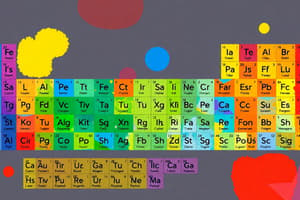Podcast
Questions and Answers
What is the Periodic Table?
What is the Periodic Table?
- A table of nonmetals only.
- A table of chemical elements arranged in order of atomic mass.
- A table of metals only.
- A table of the chemical elements arranged in order of atomic number. (correct)
What is a Chemical Group/Family?
What is a Chemical Group/Family?
A column of elements in the periodic table.
What is a Chemical Period?
What is a Chemical Period?
A row of elements in the periodic table.
What is the Atomic Number?
What is the Atomic Number?
What accounts for almost all of the mass of an atom?
What accounts for almost all of the mass of an atom?
What is a Valence Electron?
What is a Valence Electron?
What does Malleable mean?
What does Malleable mean?
What does Ductile mean?
What does Ductile mean?
What is a Metal?
What is a Metal?
What is a Non-metal?
What is a Non-metal?
What is a Metalloid?
What is a Metalloid?
What are Alkali Metals?
What are Alkali Metals?
What are Alkali Earth Metals?
What are Alkali Earth Metals?
What are Halogens?
What are Halogens?
What are Noble Gases?
What are Noble Gases?
What are Lewis Structures?
What are Lewis Structures?
What is a Bohr Diagram?
What is a Bohr Diagram?
What did Dmitri Mendeleev do?
What did Dmitri Mendeleev do?
How did Mendeleev arrange the elements?
How did Mendeleev arrange the elements?
How did Mendeleev's table differ from today's Periodic Table?
How did Mendeleev's table differ from today's Periodic Table?
Flashcards are hidden until you start studying
Study Notes
Periodic Table Overview
- A periodic table is a chart of chemical elements organized by atomic number, showcasing their properties and relationships.
Chemical Groups and Periods
- A chemical group, or family, refers to a vertical column of elements in the periodic table that exhibit similar chemical behaviors.
- A chemical period represents a horizontal row in the periodic table, with period 1 being the first row.
Atomic Properties
- Atomic number signifies the count of protons in an atom's nucleus, influencing its chemical characteristics and position on the periodic table.
- Atomic mass reflects the total number of protons and neutrons, accounting for nearly all an atom's mass.
Electrons and Their Roles
- Valence electrons are those in the outermost shell and determine how an element reacts chemically.
Material Properties
- Malleability describes a material's capacity to be deformed or shaped without breaking.
- Ductility refers to a material's ability to be stretched into thin wires.
Classification of Elements
- Metals are hard, shiny, and possess properties like malleability, ductility, and good conductivity of heat and electricity.
- Non-metals are elements that do not exhibit metallic characteristics.
- Metalloids, such as germanium and silicon, have properties intermediate between metals and non-metals.
Specific Element Categories
- Alkali metals (Group IA) include lithium, sodium, potassium, rubidium, cesium, and francium, known for their high reactivity.
- Alkaline earth metals (Group IIA) comprise beryllium, magnesium, calcium, strontium, barium, and radium, characterized by their reactivity and metallic behavior.
- Halogens (Group VIIA) feature elements like fluorine, chlorine, bromine, iodine, and astatine, recognized for their high reactivity and tendency to form salts.
- Noble gases (Group 0) include helium, neon, argon, krypton, xenon, and radon, known for their lack of reactivity due to filled electron shells.
Chemical Bonding and Models
- Lewis structures visually depict the bonds between atoms in molecules, illustrating lone pairs of electrons.
- Bohr diagrams represent the model of electrons orbiting the nucleus in fixed paths, established by Niels Bohr.
Historical Context of the Periodic Table
- Dmitri Mendeleev developed an early version of the periodic table, organizing elements by atomic mass and similarities in reactions.
- Modern periodic tables are organized by increasing atomic number, differing from Mendeleev's initial arrangement based on atomic mass.
Studying That Suits You
Use AI to generate personalized quizzes and flashcards to suit your learning preferences.




